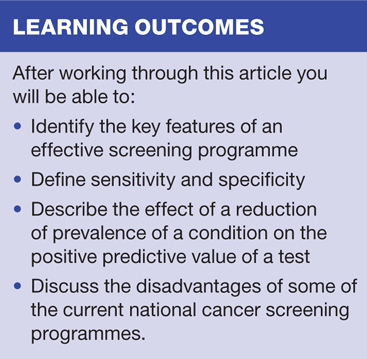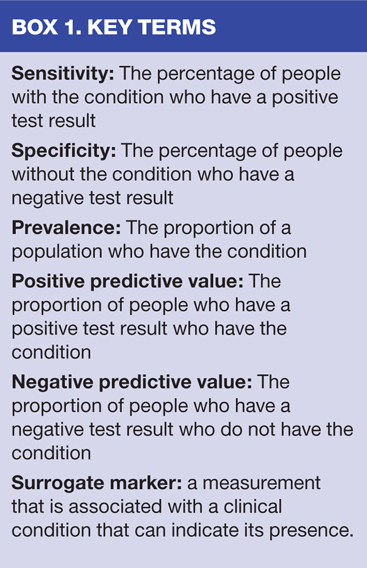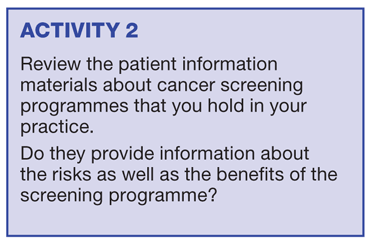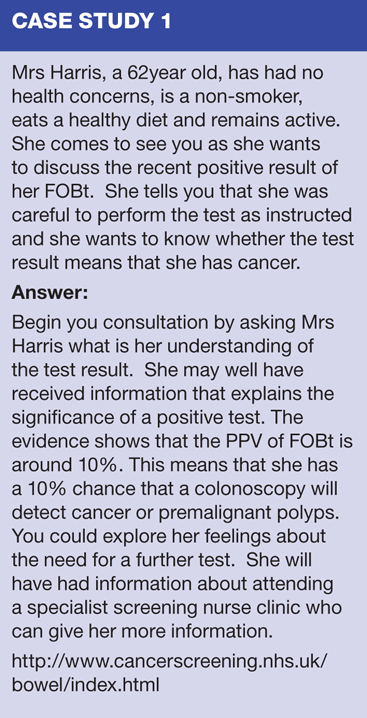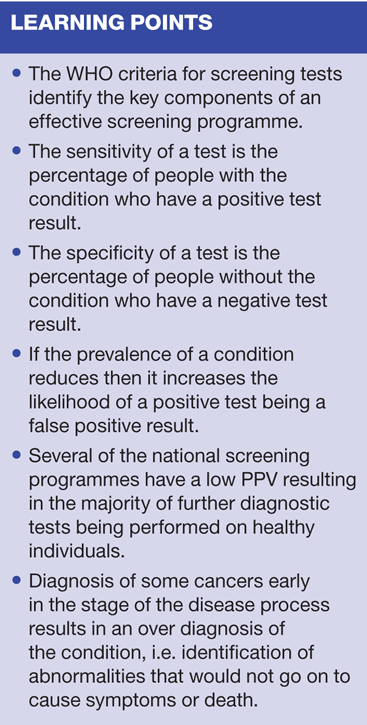
National cancer screening programmes: Risks, benefits and concerns
Hannah Waterhouse
Hannah Waterhouse
MSc BSc RN RHV Dip Adult Edn.
Clinical lead for Heart Failure and Non-Malignant Palliative Care, Education for Health
Heart Failure Specialist Nurse, Derbyshire Community Health Services
Several well established cancer screening programmes in the UK have been shown to reduce mortality through early detection and treatment, but there are disadvantages and dilemmas associated with screening as well as the obvious advantages and benefits
Worldwide, a great variety of screening programmes aimed at detecting conditions and reducing mortality by early treatment have been implemented. Some of the UK programmes — for cervical cancer and breast cancer have been established for over 20 years.1,2 Others e.g. colorectal cancer have been introduced more recently.3 Conditions such as prostate cancer are currently being investigated to assess whether it is possible to establish an effective screening programme for them.4 However, questions remain. Are all screening programmes effective and by what criteria should they be judged?
This article examines the evidence surrounding established cancer screening programmes and considers whether they are an effective utilisation of limited NHS resources and in the best interests of the individuals participating in the programmes. This article uses the WHO criteria for screening tests to explore some of these issues, particularly with regard to the potential harms caused by over diagnosis and treatment. The terminology used is defined in Box 1.
WHO CRITERIA FOR SCREENING PROGRAMMES
The World Health Organization (WHO) spent some time deliberating over what a good screening programme should entail, and came up with a list of criteria.5 (Box 2)
The programme should screen for a common condition that:
- has a significant health impact on the population
- is treatable, and
- has better outcomes if detected early.
The test should be acceptable to the population being tested, specific to the condition (few false positives) and sensitive in picking up the presence of the condition (few false negatives). In addition the costs, in terms of the screening, diagnosis and treatment costs, must balance against the health gain of the population.
PREVALENCE OF THE CONDITION IN THE POPULATION
In order for a screening programme to be effective there needs to be a significant prevalence of the condition in the population being tested. This is the rationale for targeting specific groups of individuals who are at higher risk of a specific cancer e.g. over 26 years for cervical cancer screening.
If there is a low prevalence then a large number of individuals will have to be screened to identify the few who have the condition. Another, unwanted consequence of a low prevalence is an increase in the likelihood of a false positive result. This reduces the positive predictive value (PPV) of the test. (Table 1)
There is currently some disparity in the population to be screened for colorectal cancer in the different countries of Great Britain, with some screening programmes aimed at the population between 50 years and 74 years and others not offering the screening programmes to those under 60 years.6 Screening across the maximum population is planned to be rolled out nationwide in the near future.
Offering colorectal screening to younger people could have some negative implications. Colorectal cancer is associated with advancing age.7 The younger the population screened, the lower the incidence of the condition in that population. This increases the proportion of people who will have a false positive test and be subjected to unnecessary further investigation.
ACCEPTABILITY OF THE SCREENING TEST
The higher the uptake rate of a screening programme then the greater the potential benefit to the population in terms of identifying individuals with the condition.
One of the influencing factors to uptake rate is the acceptability of the test.5 Colorectal cancer screening with the faecal occult blood test (FOBt) requires individuals to take several stool samples and post them to the screening laboratory. Uptake of the programme is low with between 40% and 60% of those eligible taking up the initial offer of screening.8 However this may still be a more acceptable option than the alternative, optical colonoscopy, screening test.9
Interestingly the uptake of the cervical screening programme is reported as 78.6%,10 which suggests that it is too simplistic to say that it is purely the acceptability of the test that dictates the uptake rate. It is just one of the factors.
ACCURACY OF THE SCREENING TEST
In any screening programme, the aim is to identify those individuals who have got the condition at an early, treatable phase of the disease. Some screening programmes are more effective at this than others. If the test is very sensitive it is likely to pick up most individuals with the condition, but it is important to also exclude as many individuals as possible who do not have it. This is in order to reduce the need for otherwise healthy individuals to be exposed to further investigations, with their associated risks and financial costs. As illustrated in table 3 the PPV of the tests used in current screening programmes ranges from 9% to 32%.
In the case of the use of FOBt screening for colorectal cancer, the test used only tests indirectly for the presence of blood in the faeces. It is not, however, specific to human blood and can be affected by other things, such as dietary intake of meat and certain vegetables. In addition to this, blood in the stools is not in itself diagnostic of colorectal cancer. There may be bleeding from higher up the gastrointestinal tract, or contamination from haemorrhoids.11 Consequently the resultant PPV value is poor (10%) with only one in ten positive FOBt correctly identifying individuals with colorectal cancer or potentially premalignant polyps.12
The evidence for the use of prostate specific antigen (PSA) testing for prostate cancer seems to be better, with between 10 and 32% of those with a positive PSA being identified by further testing as having cancer of the prostate.13,14 However, this does not mean that treatment would be the best option for all those identified.4
'GOLD STANDARD' DIAGNOSTIC TESTS
Once an individual has been identified by the screening test as potentially having the condition then, usually, further diagnostic tests are required. The 'gold standard' is the best test available, used under reasonable circumstances (e.g. not requiring the removal of an organ) that will diagnose the condition. Ideally, the gold standard test should be 100% sensitive and 100% specific for the condition. In the real world, this is rarely the case. Therefore, those individuals identified by screening will need further tests that may give a false positive or false negative result.
The 'gold standard' for diagnosing prostate cancer is transrectal biopsy.15 There is still, however, a risk of both false negative results from this investigation, and over diagnosis (of up to 50%) of cancer which would not have led to any clinically significant disease.16
Similarly, the diagnostic test for colorectal cancer used in the UK is optical colonoscopy. However, there is evidence that this investigation can under-diagnose pre-cancerous structures depending on their shape or location.17,18
It is known that in some situations asymptomatic cancer, i.e. the presence of cancerous cells without symptoms, does not progress to a symptomatic phase, or cause death over the lifetime of the individual.19 There has been considerable controversy in recent years, following the publication of a Nordic Cochrane review that estimates that '[as many as] one in three breast cancers are over-diagnosed.'20
The authors assert that these women have had needless treatment for breast cancer that would not have caused death or symptoms.
HARM CAUSED BY SCREENING PROGRAMMES
Screening programmes are often discussed in terms of their benefits to society, particularly with regard to early diagnosis and treatment of potentially lethal conditions. However, in order to ensure informed consent is obtained, the disadvantages of the screening procedure also need to be explained. As has been discussed, there is the potential for over diagnosis of some conditions, resulting in individuals being subjected to unnecessary and potentially harmful treatments.20,8
Sometimes the diagnostic procedure itself has some risks. The recent review of the first one million FOBt screenings in England indicated that there was a 0.09% rate of perforation of the bowel during the diagnostic colonoscopy.8 This may seem inconsequential compared with the benefits of early treatment of colorectal cancer, but many of these adverse events are likely to have occurred in otherwise healthy individuals.
In prostate cancer screening, the diagnostic test that would be used is a transrectal ultrasound guided biopsy of the prostate. This procedure has potential adverse effects of bleeding, infection and pain.4 With the current paucity of evidence that screening for prostate cancer reduces mortality, the harms of the diagnostic test have even greater relevance.
COST EFFECTIVENESS
It is often difficult to quantify the cost effectiveness of screening programmes as the costs of the programme need to be set against the reduction in productivity if people are off work, as well as the reduction in future costs of treatment at a later stage of the disease if it is not detected early. Therefore the effectiveness of a programme is often described in terms of the number of lives saved.
The results of a 20 year follow up study of colorectal cancer screening indicates that 638 individuals needed to be offered screening for 6 years to prevent one death over a 20 year period.21
The quality of the research evidence for prostate cancer screening has come under scrutiny and there is dispute as to whether a screening programme would actually lead to a reduction in prostate cancer mortality.4 However, in a European study for screening for prostate cancer it has been estimated that within the 55-69 year age group 1,410 men needed to be offered screening and 48 would need treatment to prevent one cancer death in 10 years.22
REDUCTION IN MORTALITY
The aim of any screening programme is the early detection of the condition with a view to more successful treatment. Many of the programmes have established that they reduce the mortality rate associated with that condition,22-25 though there is some doubt as to whether this is the case in prostate cancer screening. The issue is complicated by the problem of over diagnosis, which may imply treatment has reduced the risk of mortality in some individuals who would not have been affected by their cancer. Furthermore, within the clinical trials, there is no statistical difference in the all cause mortality rate between those screened and those not screened as most individuals die from a cause other than the target condition.
CHANGES IN PREVALENCE OF THE CONDITION
The cervical cancer screening programme has been running in the UK since 1988 and it is estimated that there has been a substantial reduction in mortality due to detection and treatment of early changes in the cervical cells.23 However, since the discovery of the causal link between human papilloma virus (HPV) and the development of invasive cervical carcinoma26 there has been the opportunity to initiate a vaccination programme against HPV which aims to reduce the viral infection rates in women. This will have a significant effect on the incidence of cervical cancer in future populations and will cast doubt on the viability of the screening programme as it stands today.27
TARGETING SCREENING IN THE FUTURE
The benefits of genetic screening of populations to identify those at higher risk of specific cancers (breast, prostate) is now being investigated.28 This work has indicated that, by identifying high risk individuals, fewer people will need to participate in a screening programme with no reduction in the rate of diagnosis of cancer. If the cost of genetic testing is competitive, this could have a significant impact on the cost of the screening programme. Only those individuals identified as being at high risk by the genetic test would need to be screened, resulting in fewer tests needing to be preformed. This may well be the way forward in helping to limit the impact of unnecessary investigations and treatment on healthy individuals.
CONCLUSION
The NHS has invested heavily in a variety of screening programmes that have demonstrated an effective reduction in mortality rates from specific cancers. However, all the programmes have their limitations; of particular concern is the potential for over diagnosis, the acceptability and risk of the test procedure and the resultant harm that this can cause. Consideration has been given to the population groups that should be targeted by these programmes but there may be issues around increased risk of false positive tests occurring in populations with a low prevalence of the condition.
Screening programmes need to remain under constant review and should be re-evaluated in response to the emergence of new evidence and medical advances that may affect their viability. We have a duty of care, not only to those who have a condition but also to those who do not.
REFERENCES
1. NHS Cervical Screening Programme http://www.cancerscreening.nhs.uk/cervical/about-cervical-screening.html#when
2. NHS Breast Screening Programme http://www.cancerscreening.nhs.uk/breastscreen/programme-commencement.html
3. NHS Bowel Cancer Screening Programme http://www.cancerscreening.nhs.uk/bowel/nhsbcsp-organised.html
4. Ilic D, O'Connor D, Green S et al. Screening for prostate cancer: an updated Cochrane systematic review. 2011; 107(6) :882-891 http://www.ncbi.nlm.nih.gov/pubmed/21392207
5. Wilson JMG, Jungner G. Principles and practice of screening for disease. Geneva. WHO. 1968 Available from: http://www.who.int/bulletin/volumes/86/4/07-050112BP.pdf
6. UK National Screening Committee http://www.screening.nhs.uk/bowelcancer-compare
7. Ko CW, Sonnenberg A. Comparing Risks and Benefits of Colorectal Cancer Screening in Elderly Patients. Gastroenterology 2005; 129:1163-1170
8. Logan RFA, Patnick J, Nickerson C et al. Outcomes of the Bowel Cancer Screening Programme (BCSP) in England after the first 1 million tests. Gut 2012; 61(10): 1439-1466
9. Almog R, Ezra G, Lavi I et al. The public prefers fecal occult blood test over colonoscopy for colorectal cancer screening. Eur. J Cancer Prev 2008; 17(5) :430-437
10. NHS Cervical Screening Programme Annual Review 2011 http://www.cancerscreening.nhs.uk/cervical/publications/cervical-annual-review-2011.pdf
11.Fraser CG. Faecal occult blood test — eliminate, enhance or update? Ann Clin Biochem 2008; 45(2):117-121
12.Levin TR. Colorectal cancer screening: new opportunities. Surg Oncol Clin N Am 1999;8:673—691
13. Grubb RL, Pinsky PF, Greenlee RT et al. Prostate cancer screening in the Prostate Lung Colorectal and Ovarian cancer screening trial: update on findings from the initial four rounds of screening in a randomized trial. BJU Int. 2008; 102(11):1524—1530.
14. Catalona WJ, Richie JP, Ahmann FR, et al. Comparison of digital rectal examination and serum prostate specific antigen in the early detection of prostate cancer: results of a multicenter clinical trial of 6630 men. J Urol. 1994;151(5):1283—1290.
15.Mistry K, Cable G. Meta-analysis of prostate-specific antigen and digital rectal examination as screening tests for prostate carcinoma J Am Board Fam Pract. 2003;16(2):95-101
16. Shariat SF, Roehrborn CG. Using biopsy to detect prostate cancer. Rev Urol. 2008;10(4):262—280
17. Singh H, Turner D, Xue et al. Risk of developing colorectal cancer following a negative colonoscopy examination: evidence for a 10-year interval between colonoscopies.
JAMA 2006 ; 295(20): 2366-2373
18.Pickhardt PJ, Nugent PJ, Mysleviec PA, et al. Location of adenomas missed by optical colonoscopy. Ann Intern Med 2004;141: 352—359
19.Black WC. Overdiagnosis: An underrecognised cause of confusion and harm in cancer. J Nat Canc Inst 2000;92(16):1280
20.Jørgensen K J. Overdiagnosis in publicly organised mammography screening programmes: systematic review of incidence trends. BMJ 2009; 339: b2587
21. Scholefield JH, Moss SM, Mangham CM et al. Nottingham trial of faecal occult blood testing for colorectal cancer: a 20-year follow-up. Gut. 2012; 61(7): 1036-40
22.Schroder FH, Hugosson J, Roobol MJ et al. Screening and prostate-cancer mortality in a randomized European study. N Engl J Med 2009;360:1320—1328.
23.Peto J, Gilham C, Fletcher O et al. The cervical cancer epidemic that screening has prevented in the UK. Lancet 2004; 364(9430):249-56.
24.Blanks RG, Moss SM, McGahan CE et al. Effect of NHS breast screening programme on mortality from breast cancer in England and Wales, 1990-8: comparison of observed with predicted mortality. BMJ 2000; 321: 665
25. Parkin DM, Tappenden P, Olsen AH et al. Predicting the impact of the screening programme for colorectal cancer in the UK. J Med Screen 2008;15(4):163-74.
26. Walboomers JMM, Jacobs MV, Manos MM et al. Human papilloma virus is a necessary cause of invasive cervical cancer worldwide. J Pathol 1999;189(1):12-19
27.Franco EL, Cuzick J, Hildsheim A et al. Chapter 20: Issues in planning cervical cancer screening in the era of HPV vaccination. Vaccine 2006; suppl 24(3): 171-177
28.Pashayan N, Duffy SW, Chowdhury S et al. Polygenic susceptibility to prostate and breast cancer: implications for personalised screening. British Journal of Cancer 2011; 104(10): 1656-1663
29.Kerlikowske K, Grady D, Barclay J et al (1993) Positive Predictive Value of Screening Mammography by Age and Family History of Breast Cancer JAMA.270;20:2444-2450
Related articles
View all Articles

